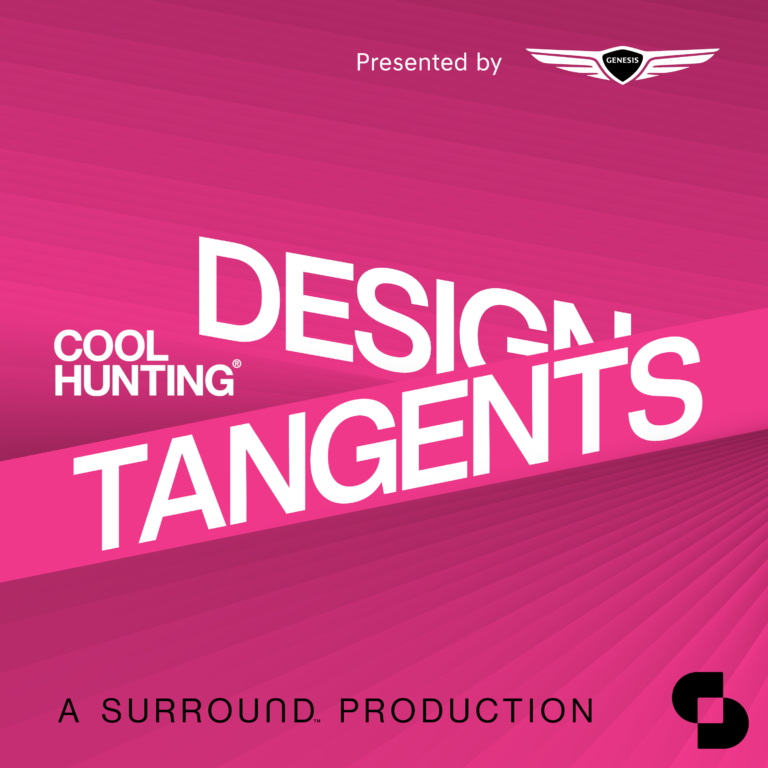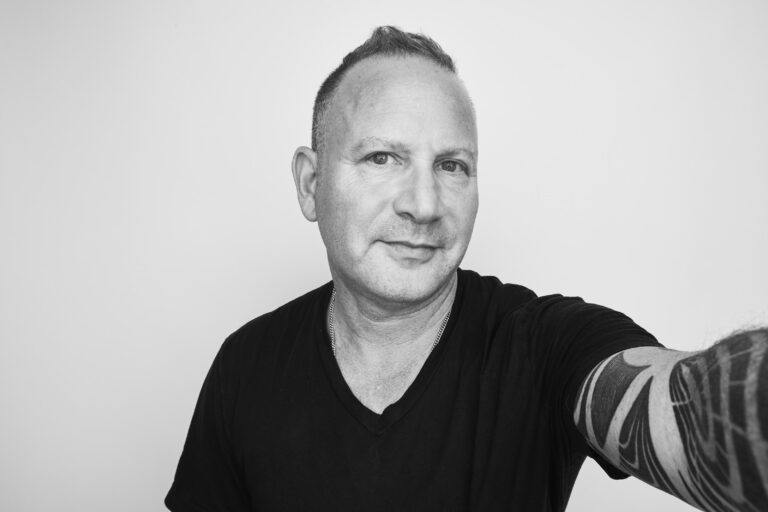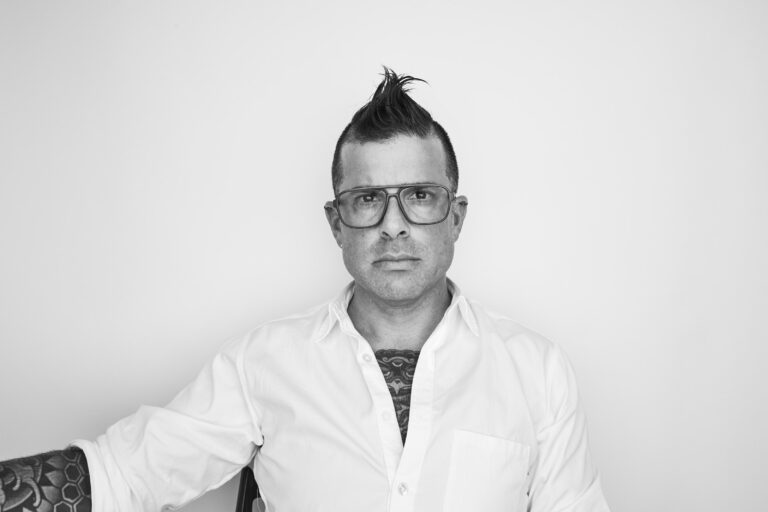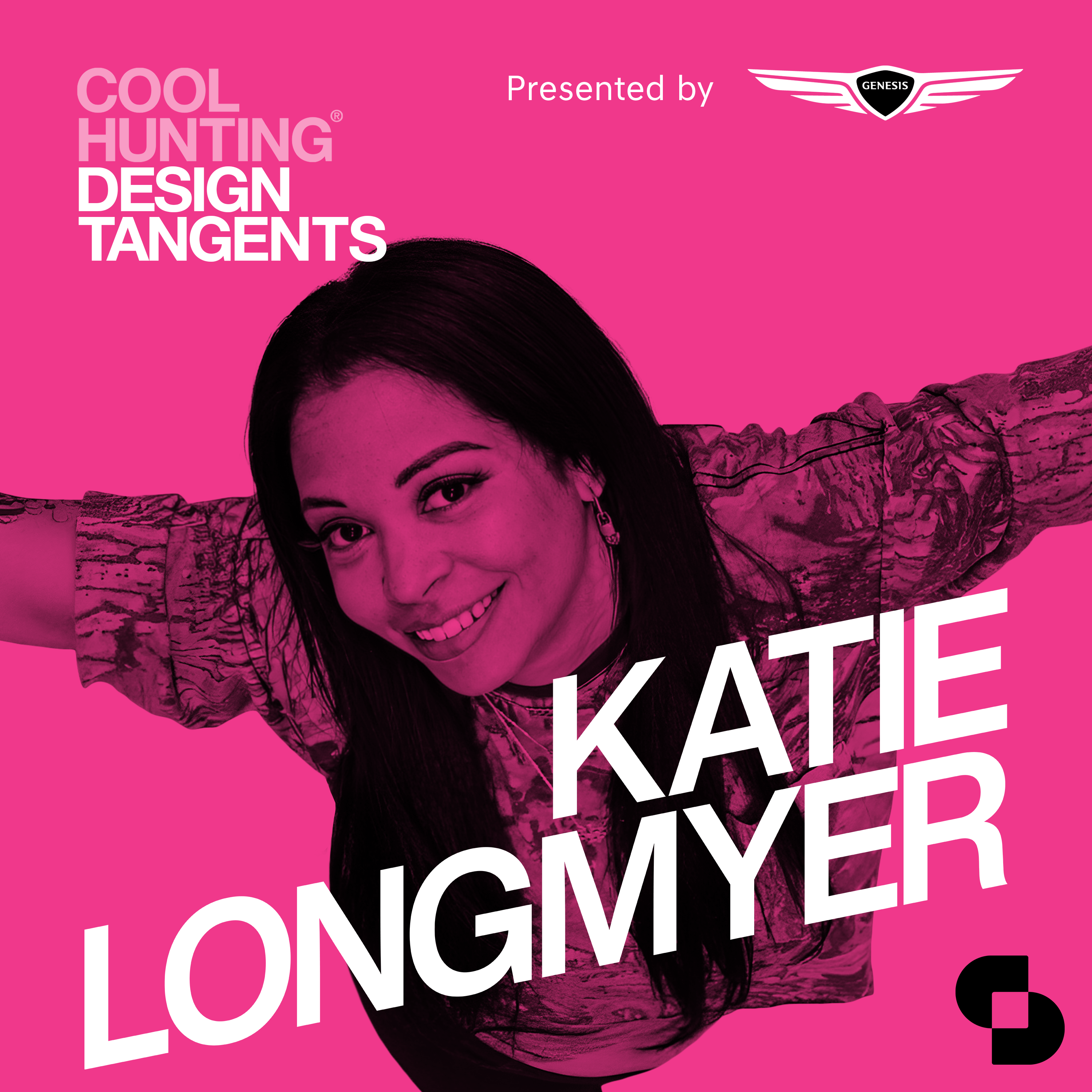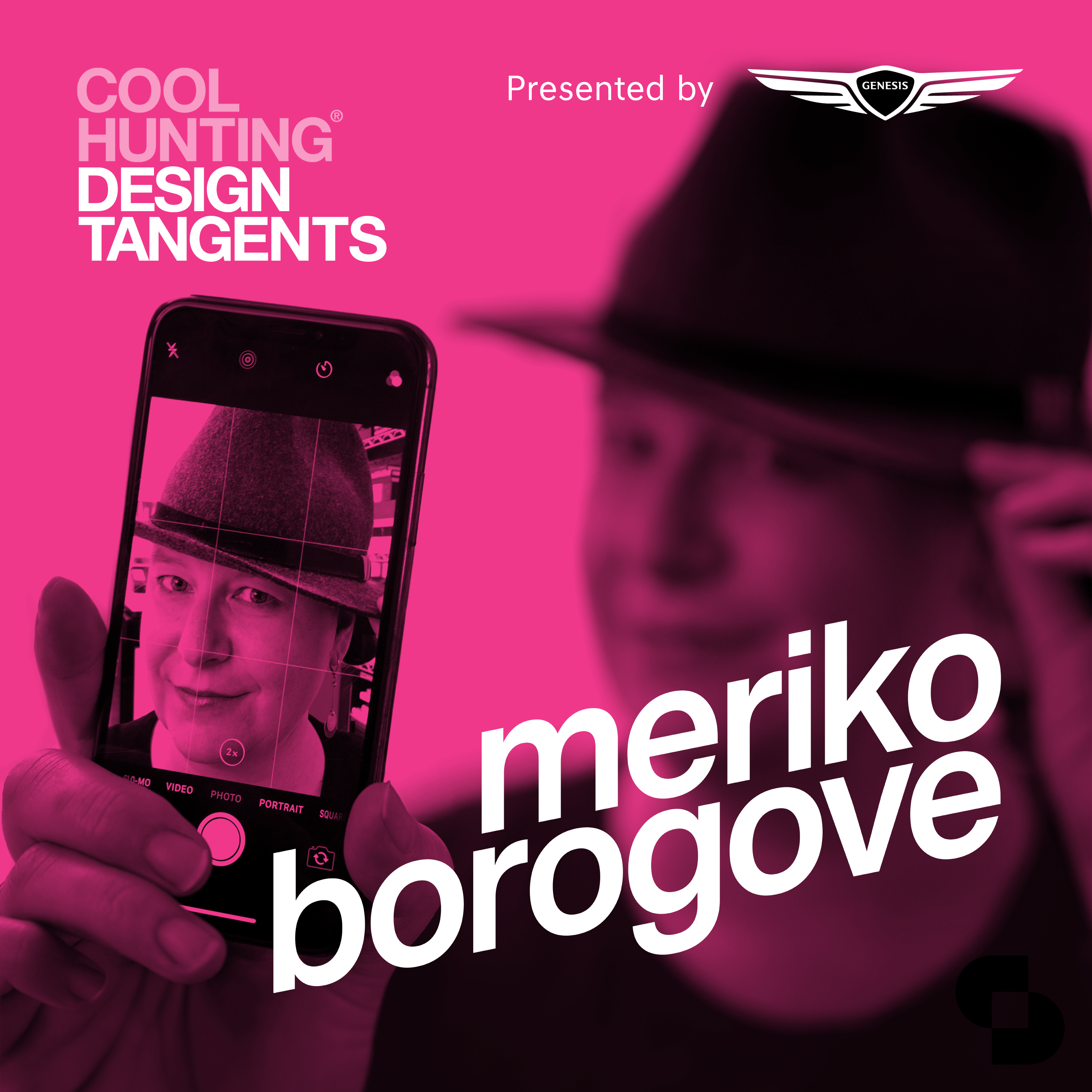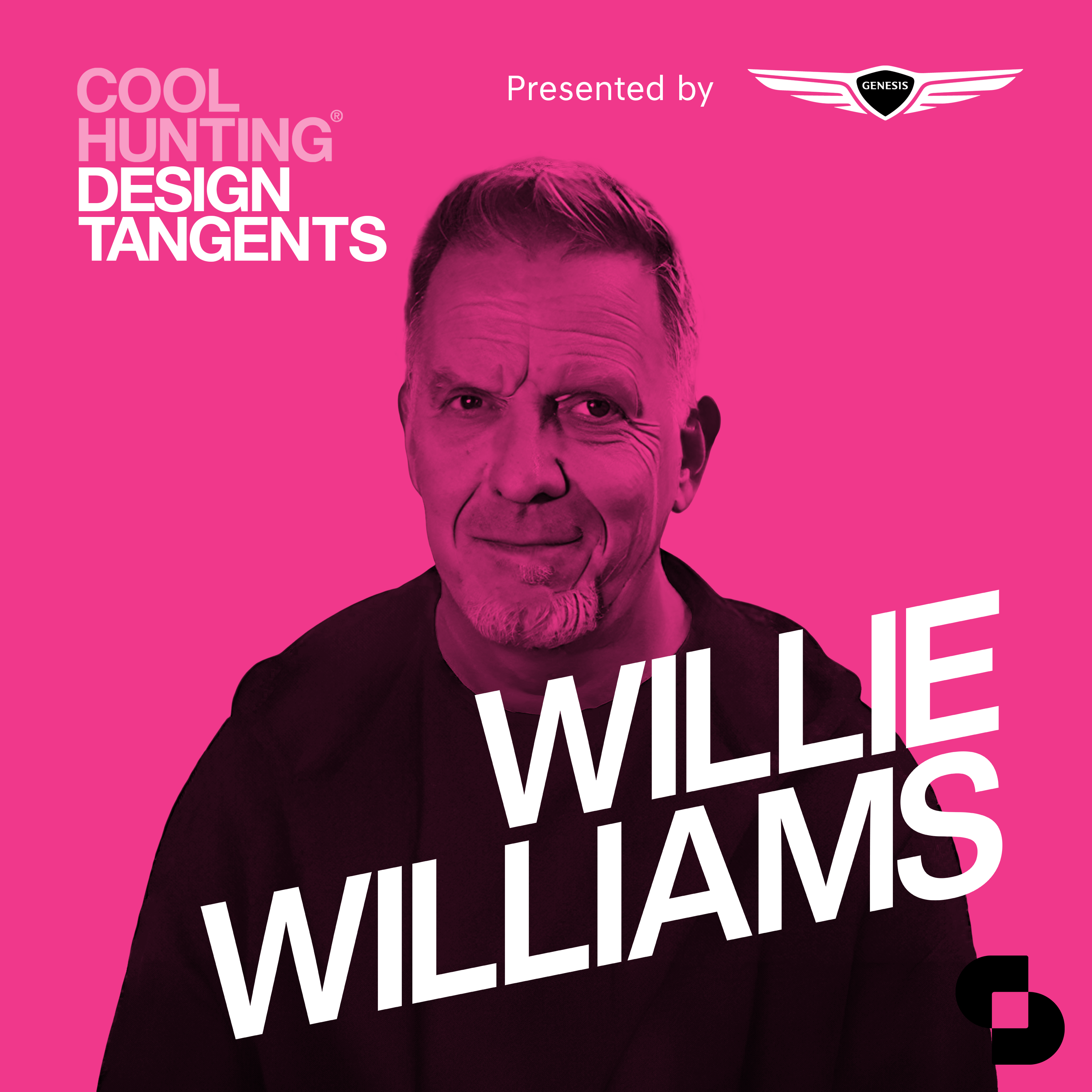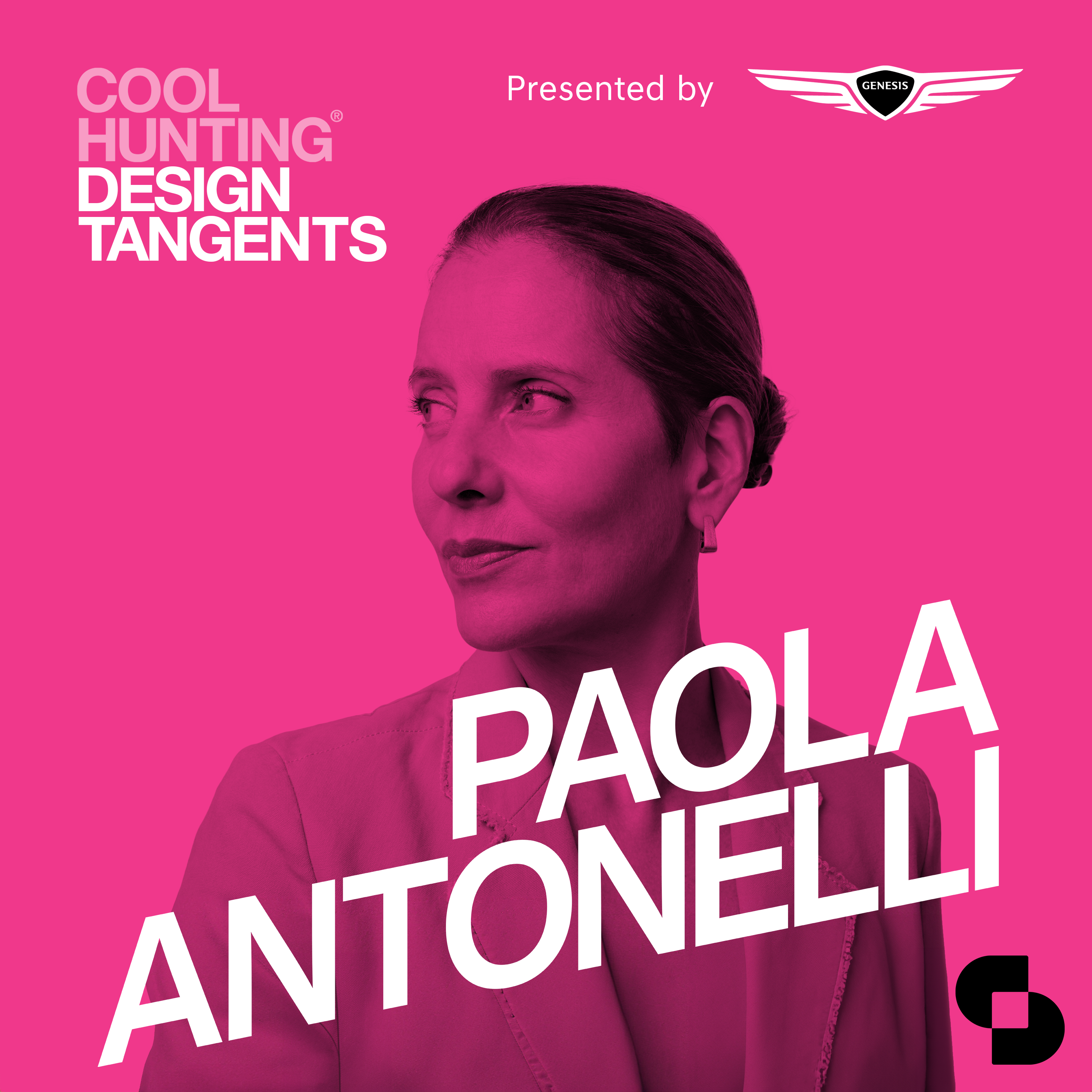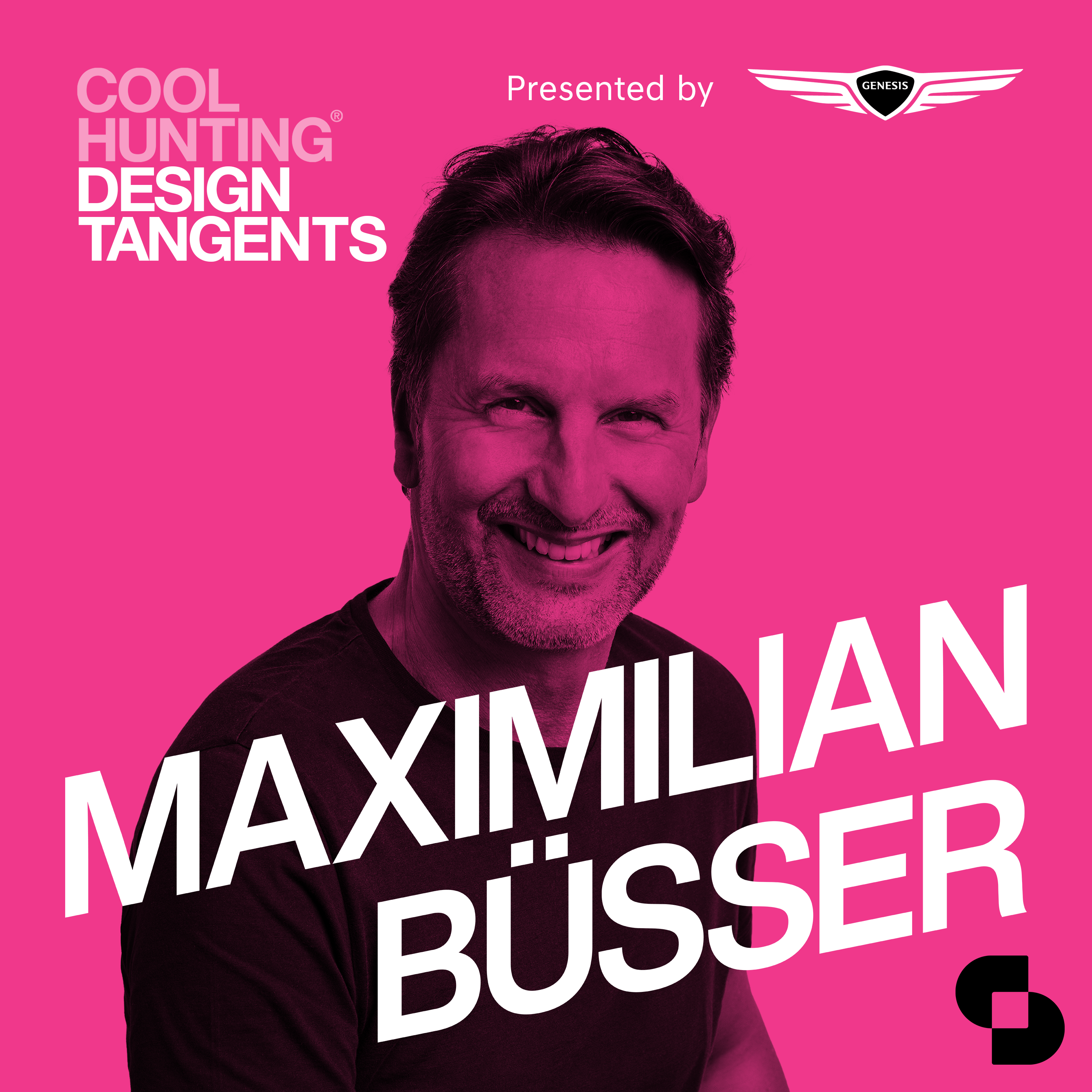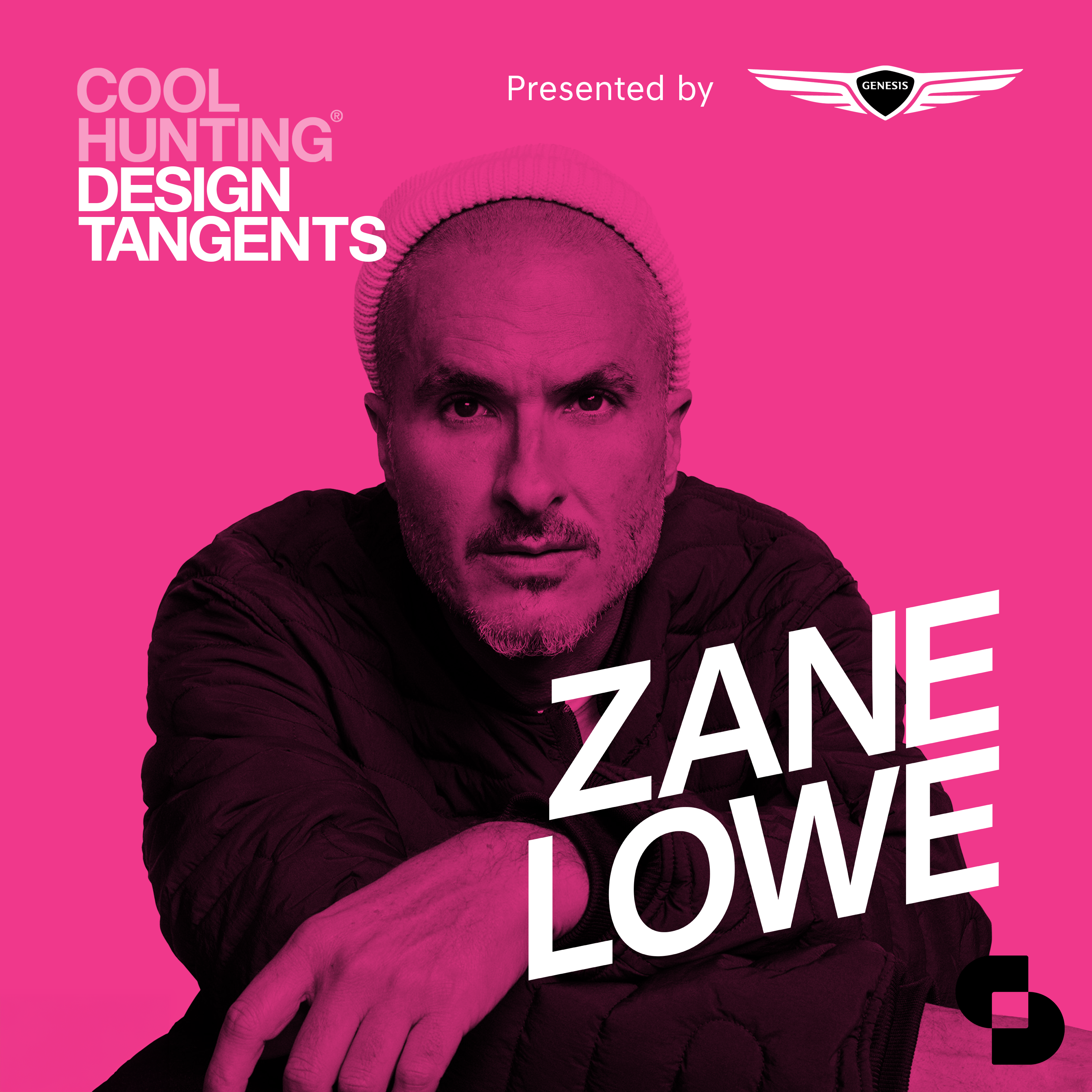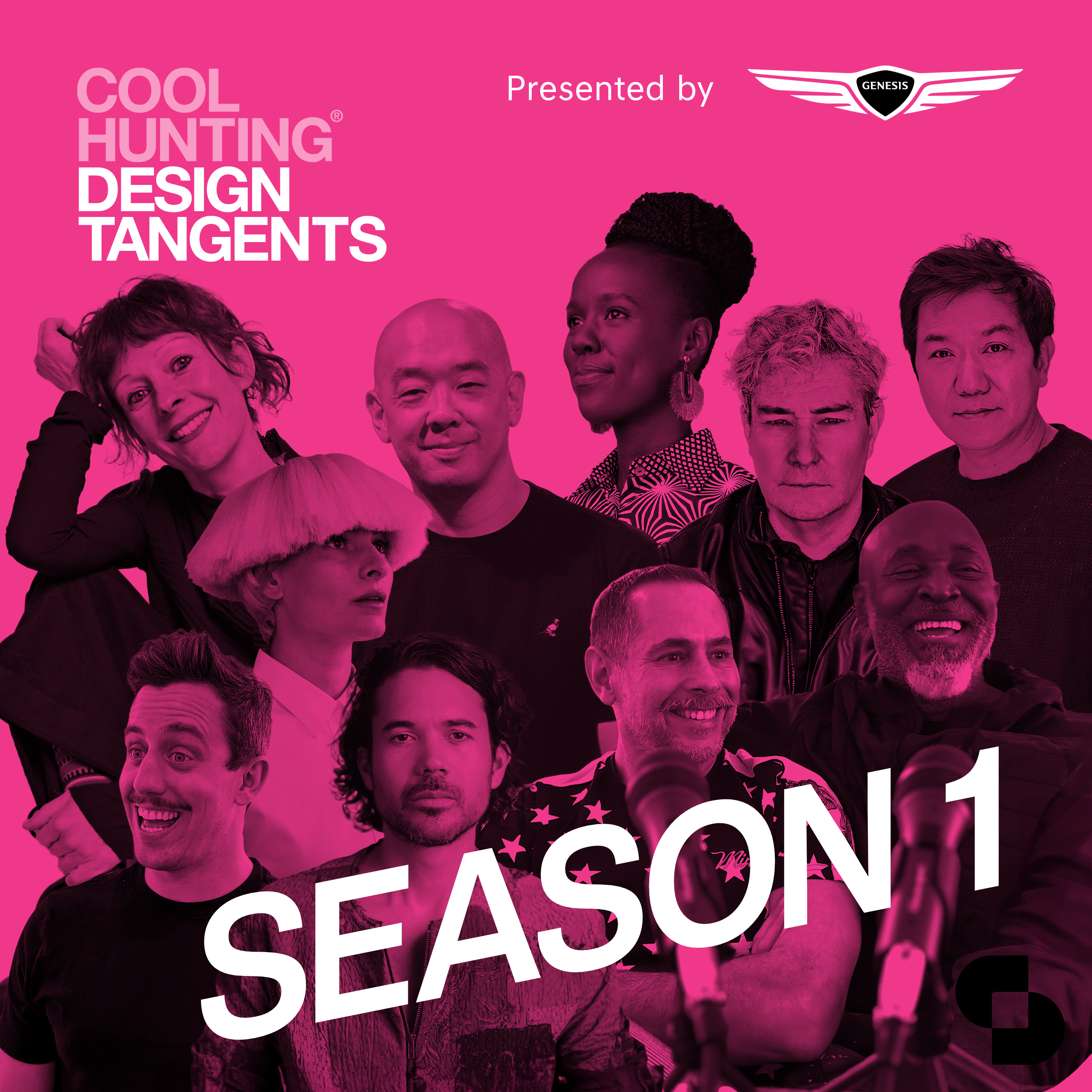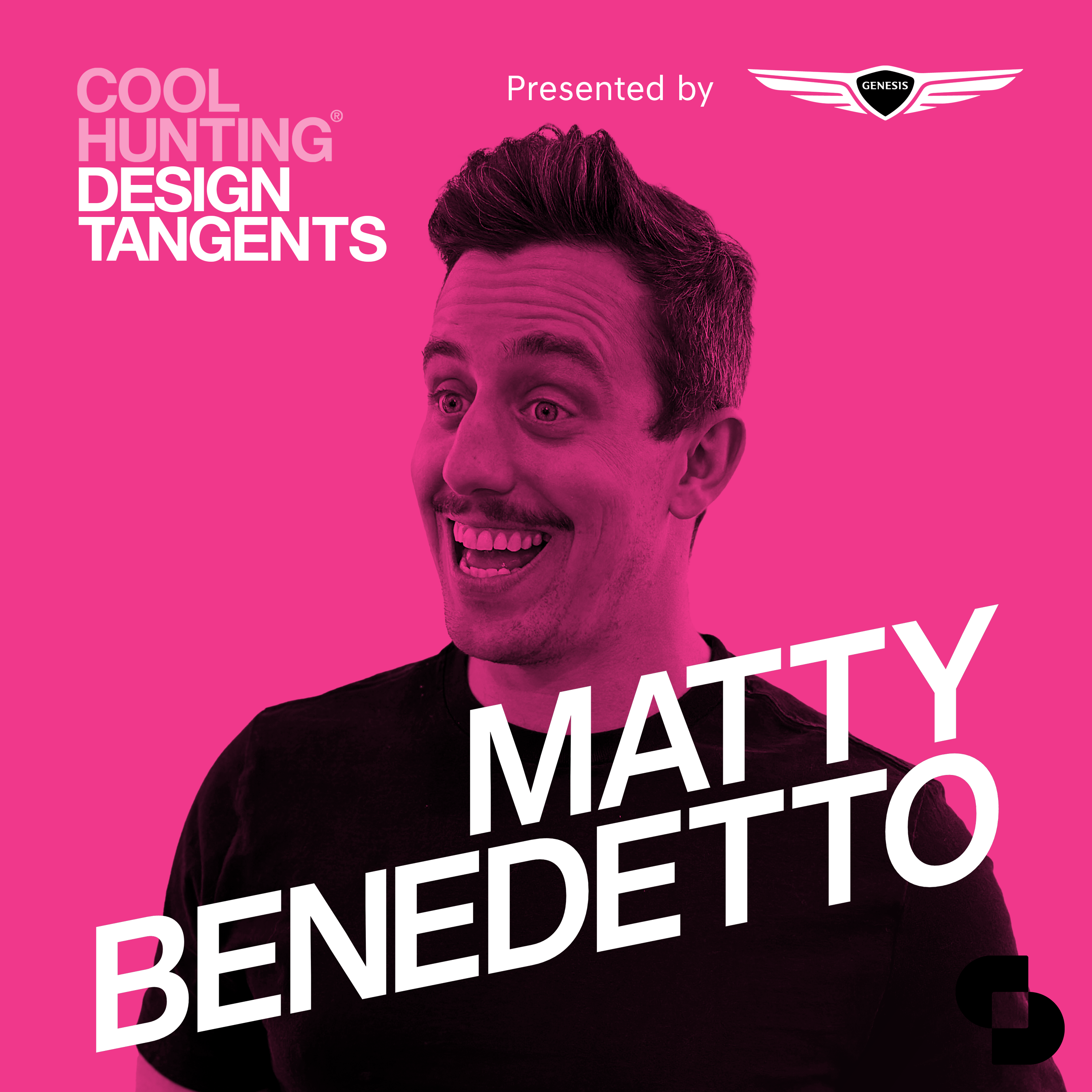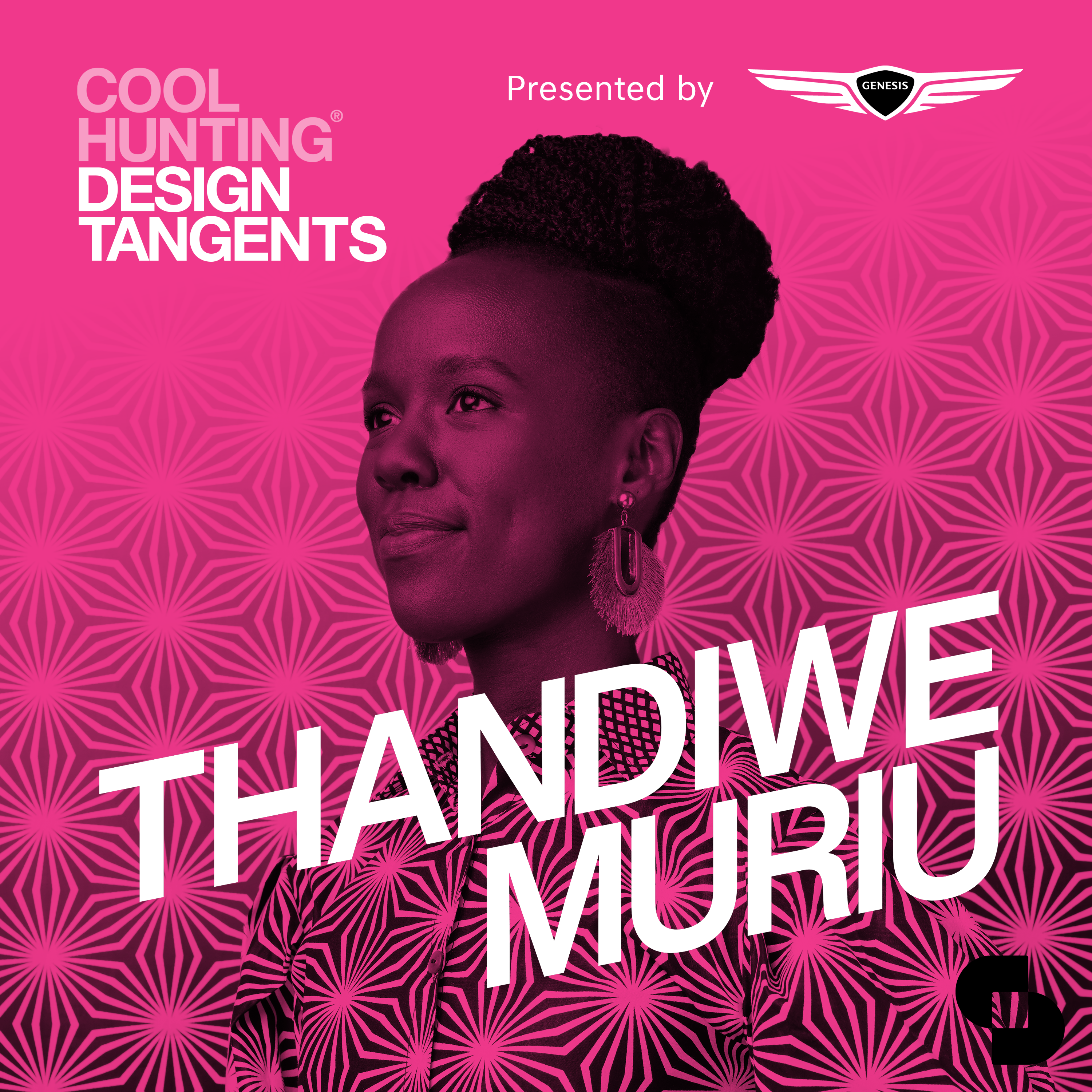Suchi is the founder of her eponymous firm, Reddymade. From her large interactive public art works at The Smithsonian, in Times Square and Prospect Park to her range of architectural projects including Google’s first retail store, Suchi has been a passionate thought leader in creating spaces that make us feel. A longtime friend of COOL HUNTING, Evan and Josh are excited to share her point of view on built environments, art, and design justice.
Discover more shows from SURROUND at surroundpodcasts.com.
This episode was produced by Rob Schulte.
Design Tangents is presented by Genesis.
This transcript was generated by an automated service. In some cases it may be incomplete or inaccurate due to inaudible passages or transcription errors.
Suchi: [00:00:00] I will make it serene for whatever it is you want. Because I want to try to understand what the feeling, the space, and the project needs to communicate.
Evan: Welcome to Design Tangents, a podcast from CoolHunting, exploring the creative processes and inspirations that drive changemakers. I’m Evan Ornstein.
Josh: And I’m Josh Rubin. Evan, do you think design is emotional or logical?
Evan: Josh, like, what do you mean? It’s both.
Josh: Yeah, I know. It’s, it’s like a logic sandwich on two poofy slices of emotional bread, but at least thinking about the creative process as it parallels taking a bite of that sandwich, that sandwich, that sandwich with emotional poofy, you know, bread and logic in the middle.
Evan: I think this is what happens when you record a podcast and you don’t have lunch. As you think about poofy sandwiches,
Josh: I maybe I’m hungry. Yeah.
Evan: Um, I don’t know to me, I think It reminds me of how people always ask us what’s cool or what makes something cool and as if there’s some kind of objective truth to that.
Josh: Yeah,
we don’t really believe in objective truth. That’s why we describe cool as an emotional response. It’s that feeling you get when something is inspiring, when it’s motivating, when it’s interesting, when it’s clever,
curious.
Evan: And that’s exactly why I think brands chase cool. Because when you see something and you get those feelings, You want it, you need it, you want to buy it, you need to have it.
Josh: So, I’ve been thinking a lot about the design process and how to balance emotion and logic along the way. We all know the old adage that form follows function. I guess solving for a functional need offers some emotional satisfaction. But that [00:02:00] suggests that the emotion is secondary.
Evan: Josh, that’s a really great segue to introducing architect and artist and a good friend of ours, Suchi Reddy, because she’s constantly thinking about neuroaesthetics and her mantra is form follows feeling.
Suchi: Nice to be here with you, both. So lovely to see you again, actually. I’m
Josh: so happy we’re doing this in person in your office in New York and get to get to look in your eyes while we have this
Suchi: chat. Yes. And me in both of yours. Thanks for sitting down with us. My pleasure. I was going to talk about how I designed everything.
I just never thought of a sandwich before. I
Josh: don’t know where that sandwich thing came from. I was just kind of thinking about the, the kind of the dance between, you know, emotion and logic in the design process. And I, and I, and I feel like there’s emotion in the beginning and emotion in the end, and there’s.
Period in the middle where you need to just figure out how to make things work, and it’s much more of a a pragmatic step Mm hmm, and I’m hungry so it we can get you some food
Evan: Um, Josh now we’re talking about when we met and that was almost 10 years ago We met through a mutual friend who was already joining us on a trip to Zambia and he said hey I really would like to
Suchi: And I am so grateful for the fact that he put us together.
It was a really great trip. It’s led me to lots of beautiful experiences with the two of you and with so many other amazing people that you bring together. So it’s really been one of the joys of my life, truly. It
Evan: definitely is a point in all of our lives where a lot of things happened and things have evolved and sprouted and grown from there.
One of the things you do is teach. One of the things we do is like to be a little bit Disruptive and not like other things. So when we travel, we like to do things that are different. We also like to include some kind of like, how do we engage with [00:04:00] the local community? How do we do something that’s charitable in some way?
And one of the things that we did on that trip was we asked our guests if they wanted to host like a one hour workshop for the local high school in this extremely remote part of Zambia. And you and one of our other guests said, Sure, we’d love to do that. And we’re going to talk about design theory.
Okay. Design thinking. Yes, I do
Josh: remember that. Was it design thinking? You taught a class on design thinking to a bunch of high school kids in Zambia.
And
Suchi: they were amazing. They really were amazing. I still remember the looks on their faces. I think one of the most rewarding things, um, that happened to me on that trip.
And actually, I have to go back to this idea of inspiration that I think you guys like to curate into these trips, because that’s certainly what people who go take away from it. And that’s what stays in my mind. You know, I was inspired by those kids as much as they were inspired by things we were talking about.
And words like design thinking were not things that were over their heads. You know, and we, we tend to think that, um, there’s a certain kind of speak that happens within a small world that we engage in. And I think what’s so beautiful about stretching and going to places and people who don’t normally come into contact with the things we say or do is to really just realize that.
There is a commonality to what we feel as humans and what we want as humans and that we can put this all together. And
Evan: that the world is changing. I mean, it’s changed a lot since that trip almost 10 years ago, where now everyone’s on social media, even in remote parts of Zambia, and they have access to things that they previously wouldn’t have.
Um, so it’s a really interesting thing, but I love that we did that. I love that you participated in it. And we intentionally made that the first day of the trip. So typically you would go there and you would go on safari the first day. No one really went to town because it wasn’t like a touristy town that you would go to.
It was almost, it wasn’t forbidden, but it was not something that anyone really ever did. And we said we felt like we needed [00:06:00] to do that and we needed For us to have that experience and we needed for our guests to have that experience too. And that kind of was more important to set the tone in the place and, and ground you to where we were than just going on safari and looking at it.
Suchi: No, I totally agree. It was successful.
Evan: That trip
Josh: was. Like 12 years after you started your practice, I want to go back just a little bit further to, what was it, like 2002? Yes,
Suchi: 2002 in August. So we’re now 21 years old at Readymade, the firm that I founded here in New York City. And, um, as I say, finally old enough to drink.
Um, and looking forward to it,
Evan: that’s a good one. Tell us what that ride has been
Suchi: like. You know, it’s been an incredibly, um, sustaining, I would say is the first word for it. And, um, I don’t mean that, you know, certainly so much from a financial sense, but really from a kind of a spiritual sense. And looking back now at 21 years of work, finally, everything starts threading itself together into a body of work.
And it was very interesting, like in the beginning, you know, some people start out with a vision of a body of work, and often artists are asked to think in this way. They’re asked to say, do this and do it again five times and make it look the same. And this then becomes this body of work. And for 21 years, I’ve never done the same thing.
I’ve always done different things in different ways, looked at different tools, different innovations, different sciences and technologies and things that I could bring into my work and inspirations that I think have made this maybe a bit of an unusual ride, but a really joyful
Evan: one. You know, I think a lot of us who’ve started companies, you get to this point where you’re growing, you’re growing, you’re growing and you, you know, you’re pitching all this work and then sometimes maybe you take on a project that you know will be financially.
Beneficial for your company [00:08:00] spiritually you struggle with how have you kind of navigated this space of. As you said, like sustaining the business, but also only doing the work that you want to do and are excited to do.
Suchi: Well, the thing, the thing to remember is that the whole world is your teacher, right?
Everything shows up in your world, in your universe, in your life, in your journey to show you something, to teach you something. So whichever project we’ve taken on, and it’s a question I get very often, people ask me, well, what’s your favorite thing to do since I do so many different kinds of things? And I always say it’s everything, I could never choose.
And it’s because I learn different things from different people, from different situations. So if we take on a project, for instance, that we think is perhaps good for certain reasons, but maybe we’re not so spiritually aligned with, which doesn’t happen very often at all in the studio, it still becomes a place from which a learning comes that I then see translate into several other things.
And, uh, you know, there’s so many examples of this in the studio. If you ever talk to anyone who works with me, they’ll tell you, Oh yeah. Oh, yeah, we know where that came from. You know, we learned that from this place and we’re using it in this place in this different way. And that’s why I think it’s been, um, sort of part of the kind of business mantra has been to say yes, because I never know what I’m going to find out.
Josh: When we think about an artist or an architect and we think about their body of work, we often look for some kind of aesthetic through line. You know, what is what is the signature form or? material or what have you. And I’m wondering if there’s a signature emotion given the mantra of form follows feeling and the fact that you work with different clients.
So part of what you’re doing is channeling their energy, channeling their, their, their feelings, their vision and merging it with your vision and your emotion and creating something. [00:10:00] Is there an emotional through line? It’s your
Suchi: body of work. You know, it’s so interesting because this question of style has never been one that interested me.
It didn’t even interest me when I was a student. You know, I didn’t look at people’s work and go, Oh, that’s this style or that’s that style. And it’s interesting to me because of a style. It’s interesting to me because of the substance, because of the idea that that’s being explored. And I always tell people, they say, Are you a modernist?
Are you? You know, I am. Yes, I’m all of those things. But mostly I say I’m a serenist. I will make it serene for whatever it is you want. So if you’re a maximalist, that’s what you’re going to get from me. If we’re, if you’re a developer and you want me to give you a really, you know, beautifully energizing space, that’s what I’ll do because I want to try to understand what the feeling, the space and the project, whether it’s an artistic work or it’s a work of architecture needs to communicate.
And really, um, come across with a certain power and energy that it remains embodied in people’s bodies. So I always say I want to bring the discussion of design not to style, but away from style to what I call the democratic space of the body. So I want people to be able to understand it through their senses, through their feelings, and to really come back to this place where we’re all equal, by the way.
And socioeconomic differences, cultural differences, they don’t really affect us as much as we think in this place. And I think we really need to come from this place to have a really authentic response. to what we’re experiencing in the world.
Evan: You do a lot of things in your practice. You do residential work.
You do retail spaces. You do various kinds of business things, offices or showrooms. Um, and you also do something that to me is, is really special. And I think where I’ve seen you be the most excited, which is in the public art space. And is that, I mean, obviously that’s you and this is your firm. So this work really well together.
[00:12:00] Is that like pretty a typical mix?
Suchi: It is not at all the typical mix. I would say, I think, um, my practice ready made is quite unusual in that it covers architecture, interior design, um, uh, public art installations, artistic works that are purely looked at as artistic works or can be seen that way. And we are also interested in the research, um, that underpins the field of neuroaesthetics, which looks at how.
Spaces and experiences affect our brains and bodies, you know, what is the neuroscience behind this and what is the science behind this that we can understand really how we feel about the world. And so I don’t know of anyone else who does all of those things. And as you say, Perhaps you see me get really excited about the public artworks, but that’s because there is no agenda there.
And I get to insert my own agenda. And if my own agenda is about equality, if it’s about equity, if it’s about empathy, it’s about agency, I get to impugn a project with all of that, with those examples. You know, like for instance, we did an installation at the National Building Museum called Look Here.
where I introduced pictures of activist marches in D. C. because I wanted people not just to be distracted by the reflections of them that I was creating, but also to ground them in kind of their cultural history in the place that they were, and remind them that they’re a part of this, right?
Evan: And that’s actually up right now.
It is. I think it will be closed by the time this airs in a couple weeks, but that’s a very recent project.
Suchi: It is. And, and that’s why you get, you see me get excited about it because I think those kinds of projects provide a platform where my own, um, kind of viewpoint about the world can have a voice.
Whereas when I’m working as an architect, generally speaking, I’m looking to find a viewpoint. That coincides between both what I’m interested in and what my client is interested in, you know, because that’s a collaboration much more than the artistic works are.
Josh: Is there an overlap? Is there an interplay?
I mean, I get [00:14:00] why it is important for you to make both art and architecture and to be able to share that vision and to be able to make creations that are entirely the message that you want to share. And the feelings that you want to create, has the art brought in architecture clients?
Suchi: Absolutely. Um, because it’s a, it’s a beautiful way for people to enter my mind.
You know, and then they can see that there’s a way in which I can think about it that other people are not going to think about. And really, all our clients are people who come to us because they want something different.
Josh: Are the clients that came in because of the art different from the other clients,
Suchi: though?
I would, that’s a difficult question to answer, but I would say that they tend to be much more, uh, they come to me much more supportive of an individual vision than other clients are. Other clients kind of come around to that, but generally speaking, people who’ve experienced an artwork that I’ve done can come to me with, um, a sort of a built in level of trust, you know, um, that’s already there because they know that I can interpret.
a powerful feeling and that I can convey that in a public way that will allow people to be drawn into it. And whether we’re doing a commercial space or we’re doing a space for a developer, everybody wants somebody to buy into what it is they’re trying to say. And I think the public artworks actually, in that sense, allow me or allow my clients to understand that I can do that.
Evan: You’ve done so many really interesting public artworks. One I think was called X and it was in Times Square, very unexpected to come across this artwork in the middle of Times Square. Um, he did another one, which was this really amazing installation. I want to say it was the Brooklyn Botanical Garden or Prospect Park, Prospect Park, um, a couple of years ago.
And that was really impressive. I think what’s also great about this is for the practice, for the people who work with you, that it’s different than a building, right? Or something that has a longer time frame that has a a lot [00:16:00] more rules and restrictions and regulations and, and, and I don’t want to say budget restrictions because public art, usually you’re working with very little money, but it brings a whole different kind of energy to the studio where I think people can get really excited about it and work on something really artistic.
But it’s, I don’t want to say it’s faster necessarily either, but generally the timeframe is pretty much shorter than some of these other kinds of work, larger building projects that you’re doing. And, um, potentially more emotionally
Suchi: fulfilling for some people. Well, I was actually just talking to the studio about that and I was saying that, you know, 21 years into, into doing this, what keeps me going is the fact that I feel this kind of incredible satisfaction when something’s made.
And it’s really an indescribable feeling when you see this idea that’s in your mind come to reality and really be affecting people so strongly. And I see the delight on both the people’s faces who experience it and the people in my studio who’ve seen it and made it. Right. And it’s the same feeling we have when we create a space for it, whether it’s a private client, we make their home and we see them be really happy in it, or we’re making a space, a commercial space, and we see people come in there and go, wow, and like see wonder and awe and discovery in the things that we try to do, because if you told, if you asked me, what are you trying to make, I would say I’m trying to make joyful and uplifting spaces and experiences that people can really take something away from.
And I think yeah. My studio, um, everyone who works here is very happy to see that come to fruition. And that sense of satisfaction is a very difficult thing. But
Evan: also, these are less permanent things for the most part. Right. Right. Something happens and it, it, it, A commission, a commission is awarded, you create that work, it’s presented, and then in many instances it’s, you know, when the installation’s over, it’s over, versus, you know, a store or home or an office, which has a longer lifespan.
Suchi: Yep. And I don’t [00:18:00] think that temporality necessarily has anything to do with it, though. You know, I think that sense of satisfaction that you get from seeing an idea live, and this is, this is why, you know, it’s so, it’s so, beautiful to do what I do and why I’m so excited about it is we can make a drawing that’s beautiful, you know, and when a drawing comes to life in your hands and a drawing isn’t just a drawing, it’s an idea.
It’s an idea that comes, you know, comes to reality in that form. But then maybe that drawing becomes a space. Maybe that becomes an object. Maybe that becomes an experience. And that’s another level of satisfaction. You know what I mean? So people, um, we, we learn to enjoy things on lots of different levels.
The temporality, I think is a nice thing. Um, It’s certainly when we do projects that go on for six years, seven years, you know, it’s a lot of delayed satisfaction. And this is some, you know, something that’s led me to really loving cooking because I can do that fast and I can really enjoy it.
Josh: That delayed satisfaction though, I would imagine helps create the joy in the sense that can’t really feel joy without knowing sorrow, right?
You can’t have ups without downs. Or else everything is just kind of even and, and boring. So while that delayed satisfaction is, is probably no fun when you’re in it, you need it to truly experience the joy of the, of the finished work.
Suchi: Absolutely. But I also, you know, some, something about another really kind of joyful aspect of doing what I do is that there’s never a boring moment.
Right. And this is what I’m always trying to tell people, whether it’s my students or it’s people in my studio, I’m never bored, like I can look at the edge of a table and be excited because I’m thinking about how it was made. And, you know, why does it turn that way? And what’s that material? And, you know, it’s, it’s just everything in the world prompts a new question.
And so even that process of delay is a process of learning and a process of exploration. And that’s what being a designer is all about. It’s about being in that space of design exploration. Okay. Learning innovation. And as long as we can do that, I think we’re happy creatures.
Evan: I want to [00:20:00] dig into learning exploration and happiness.
And we’re going to do that right after this quick break.
You spent a lot of time working really hard on your business and the product, the projects that are happening. You also teach. Maybe you can tell us a little bit about that. And you travel a lot, obviously for work, but personally too, travel’s a big part of your, um, satisfying your, your curiosity,
I
Suchi: would say.
Absolutely. Well, you know, um, travel is the biggest teacher, right? And if you’re an immigrant, like me, where I come from India and I came to this country, When I was 18, um, it was one of the biggest learnings of my life to really learn how to be in a different place. And, um, I’ve always loved that kind of liminal space of like being between here and somewhere else, because I feel like I’m in a doorway and I can look 360 and see lots of different things.
And that’s, that’s an aspect of travel that I love. And so I’m lucky that my work takes me around the world, whether it’s, you know, to, uh, Saloni and Milan, or it’s to freeze in London or. You know, all these different places because my interests span so many fields, whether that’s art, science, design, architecture, research, you know, there’s so many places I can go to find inspiration, to talk to colleagues, to work with them, um, that it’s been a very kind of a rich, I would say journey with that.
And it’s been
Evan: fun to share with you because we’ve been on so many trips with you traveling to different countries and having these really fun experiences.
Suchi: I’m always so happy when I’m able to go on a trip with you guys, because it’s always unexpected. And I think, you know, what you always say about being a type A person who needs a lot of control, like what you design is for type A people, where they can give up the control to you, because we trust you to have thought through the options and the choices carefully, and the learnings and the inspirations carefully.
You know, it’s not just which hotel am I staying at? [00:22:00] Where am I sleeping? You know, what does that feel like? But it’s really what is my experience like and what am I going to think about, you know, and that I think is the thing that I take away from traveling with you. Thank you for,
Josh: for seeing that. Um, we spent a lot of time thinking about how to, how to keep type A people happy because we’re type A people.
And that’s kind of how that like all the travel experiences that we created started because we didn’t want to be on a group trip with strangers. Right. The first trip that we put together, we were invited to. to go on safari. And we said, Oh, what if we just, you know, don’t, don’t sell, don’t sell those spaces to anyone else.
Let us, let us, let us pick who is going to be there. And that was very, like, that was a very self serving move for Evan and me. Cause we’re like, all right, we’re going to have this amazing experience. We want to have an amazing experience with people we love, people who are inspired by people who are going to show us a different perspective on what we’re seeing.
And that’s kind of where the travel experiences were born. Um, We’re leaving for Seoul tomorrow and we’ll be there through freeze and it’s the second year that freeze is in Seoul. You want to come with
Suchi: us? Oh my god, I wish I could. I really
Evan: wish I could. Freeze always draws a lot of energy around it, whether it’s in London or New York or LA.
From everything we’ve heard about the first Freeze in Seoul, it was just like, boom, it just like blew up and everyone was super excited about it. We’re really loving what’s happening in the art scene in South Korea, and we’re really excited to be, see how freeze, um, manifests there differently. Um, but a lot of people are talking about it.
That’s
Suchi: amazing. I’m so excited about Korea. It actually ended up being one of these, um, places that I discovered in the pandemic. Um, my, my way of traveling in the pandemic was to watch shows that were based in places and countries that I thought I hadn’t been [00:24:00] to. And I got inducted into the world of K dramas, which I didn’t realize was such a big thing.
You know, I come from the land of Bollywood. I thought that ruled the world. I had no idea, you know, and so it was really interesting. But what’s so interesting is to see all of these kinds of cultural Um, what I would call similarities really between being South Indian and Korean, which I found very, very odd and interesting.
What are, like, what,
Josh: what’s one of those similarities? Well, I think Anne, what’s your favorite K drama?
Suchi: Oh gosh, I can’t, I can’t, I can’t, there’s so many. But I would say that, um, the, some of the similarities are around food, they’re around, you know, about language also, because we have all of these ways of speaking to people where you, you have to speak with a certain degrees of politeness and how you express something to someone is very, very important.
And really how the, the culture is communal, it’s not really about the individual, and I didn’t expect that so much, you know, from that, and we’re very much like that in India, that’s how I grew up, so, yeah, I found, I found lots of, lots of things to feel oddly similar, and there’s some words in the language as well that translate, which like for father and mother, and And I thought that was interesting that
Josh: that happens across a lot of languages, like the words for parents and grandparents seem to transcend place in a pretty major way, which is really interesting.
Suchi: It must be a way the sound resonates, you know, maybe there’s a theory behind that. Someone’s thought about it.
Evan: You know, whenever I see you, I’m always thinking about neuro aesthetics because it’s Such an important part of you and your work and it’s something I’m aware of but haven’t personally kind of like grasped I’m not thinking about it all the time and I’m just kind of when we were just talking about sound Is that obviously sound is part of that?
Suchi: Right? Absolutely. Yeah Well neuroesthetics really technically is defined as the study of how your brain body experience space, aesthetics, experiences, all [00:26:00] of these kinds of things. And the more we learn about that, the more we understand about ourselves as humans. And obviously there’s a lot of, you know, well, if you know about that, can you manipulate me?
You know, I was even asked this question recently. Um, and I just said, well, you’re being manipulated all the time. It’s really up to you to, you know, understand what’s acting on you and how you respond to that, because it all comes back to human self awareness, right? Which is what one of the artworks I did at the Smithsonian was all about, called Futures.
Which was looking at all different kinds of futures, technological futures, um, uh, health futures, um, genetic futures, all kinds of things, and it was meant to be an artwork that could talk about the relationship between humans and technology. And so I designed a piece that you could speak into, and it would read the emotion in your voice, and relay that as a pattern of lights that was specific to you, that could change every time you change your word.
And every word you said affected the words of people around you, so there was a central piece that would also weave all of our feelings together. And so you knew that your feelings were important about the future and that they affected everyone around you. And that really gives you a new kind of responsibility, right?
Towards both yourself and other people to really imagine something that can work for all of us. And that was really the crux of the piece, and it was so, so, such an amazing experience to do it in this beautiful rotunda, and, um, again, to explore new worlds, because, you know, I hadn’t done a technological, fully technological piece before that, and, um, I learned a lot.
We were
Evan: fortunate enough to be there for the opening with you and to celebrate that. Can we talk about fashion?
Josh: Sure. Yeah. I asked because when we arrived, um, Evan, Evan showed you a new little acquisition, which is depending on where in the world you’re from a fanny pack, a bum bag, a festival bag, and you sort of cringed.
Evan: I did indeed. I was so excited about it because it’s multicolored and super fun and I don’t know, I’m having an 80s moment. I’d just love to hear
Josh: your, [00:28:00] your perspective on
Suchi: fashion. Again, I’m going to relate it to architecture, because I really think that we build, and again, back to this conversation of bringing, bringing the conversation of how we build our worlds back to our bodies, because I really think, and I’ve said this before, that we build our worlds outwards from our bodies.
So the first layer is our clothing, the second one may be our home, the second one might be our city, you know, our country, the world, it goes in that way. And I think there’s a through line of design and experience and feeling that goes through all of that. And fashion is one of the most amazing ways in which you can both support the person you are and also express the person that you are, right?
And people who manage to do that in a very seamless way are the people who are the most comfortable both, and we tend to say they’re comfortable in their skin. But we’re really saying they’re comfortable in their clothes, right? And that, that it projects who they are correctly. And that, that, that they exude this kind of ease in the world.
And I think it’s a very big role for fashion to play. I think fashion, fashion gets a bad rap. Um, that it’s so much more superficial than I really think it is. I
Evan: love your style because you, you mix all these things. And, and one thing, it’s so funny, like,
Josh: I was just going to go there. It’s like, why do architects love
Evan: Miyake?
Architects and designers love Issey Miyake. So do we, by the way. Um, and so you wear a lot of that, but you also wear, you have your own style and you mix it often with a lot of pieces that you get in India that are like beautifully embroidered and brightly colored and beautiful silks. Um, and I just think it’s always fun to.
go out with you because you’re always
Suchi: this great. I remember running into you on the street once and we were both wearing the same colors. It was a very bright yellow, yellow and black. Yes. Yellow and black. We were two bees on the street together. Um, no, I, I mean, I really do think fashion is very important.
In fact, I just came back from a trip to Antwerp, um, where I went to the mode museum and there was an amazing show of Man Ray. [00:30:00] Um, and his contribution and really what he learned through, through his, his work in fashion about all these styles of creating surreal styles and creating all of these photographic effects, which were really amazing, you know, and this is another thing, I think it’s the cross pollination between all of these arts that gets me so excited, you know, whether it’s fashion and architecture or it’s sound and architecture or it’s sound and art or it’s fashion and art, you know, I don’t care.
I think it’s, We live in a multidisciplinary situation and our problems are complex that way and I think we need to solve them that way. So I really feel like I always want to have like this consortium of creative people at the table whenever I think about something.
Evan: All of those things are really important and part of where we’re going and I’d love to dig in a little bit.
To what’s next? Like, what does the near future? What does the future look like? But wait, wait, let’s do that after a break.
And we’re back. And we’re back. Um, so, all of these inputs, right? The cultural inputs, fashion, art, design, travel, experiences, food. Right, we all love food. I love when you cook for us too. Um, how do all these things, you know, participate in your brain of, of what the near future is going to look like or even the far future for you?
Suchi: Well, you know, I really think that the future of design is feeling. When I say form follows feeling, I truly mean it. This is something that it’s, it’s not a new idea. It’s an idea that’s underpinned really how we experience the world from the moment we’re born. And what we’ve been doing, if you’re good at any of the arts or anything that you do, this is what you’ve been doing, right?
But I do think understanding that through the sciences is going to be the future. Whether it’s food, whether it’s fashion, you know, we’re using technology, we’re using science in such a different way. And it can really change how we do what we [00:32:00] do. I think that the future is really understanding what everybody else in the world is doing that’s going to affect what you do.
Evan: Part of what’s happening and you think about, you know, firenadoes and, and what just happened with the typhoon in California. What was that new word?
Josh: Oh, it was, it was, no, it was the hurricane. It was the hurriquake. The
Evan: hurriquake, hurriquakes and firenadoes and, and all these things that are changing the places that we live in and where we may or may not want to live in, in the future, but also the kinds of buildings or, or engineering or safety, whatever involved in all of that.
Um, is that something you, you think about
Suchi: all the time? Uh, certainly. I mean, one of our projects actually that, that I, um, it’s totally a big visionary idea, but it’s called 71 percent and was created many years ago in response to Hurricane Sandy and a call that MoMA put out, you know, for ideas to, to think about responding to this kind of situation.
And we really came up with this idea of creating almost like a secondary coastline around the world that could act as a flood break or water break, but could be a new Uh, you know, opportunity for development, for cultures, for skate parks, for floodable, you know, gardens, for cultural influences to mix.
And it’s those kinds of ideas, I think, that will come to fruition. Like, if I lived for 200 years, I’d love to see that happen. And hopefully in my lifetime, I’ll see at least a small section of that happen.
Evan: I think we’re at this point where you could live for maybe not quite 200 years yet, but I think that that is On the horizon, potentially.
Suchi: Wow. I don’t know that I fully believe that, but okay, I’ll go with you. Is that mean more travel with
Evan: you? Yes, I’ll take that. If
Josh: we can all live that long together, great. And feel good. I’m, I’m, I’m open to that. I think
Evan: that maybe the human spirit is capable of doing that. But the human body As we currently experience it probably is [00:34:00] going to need a lot of support to get us that far.
And it’s
Josh: a whole other conversation, but the planet can’t handle us living that long. Too many people. Anyway, um,
Evan: but, but speaking of that and speaking of the future, you know, architecture is a, is a Industry and, and, and practice where things are always evolving. Um, I was really excited. Josh and I were talking yesterday.
We read the story about how using coffee waste, um, and mixing it into concrete provides an additional like 20 to 30 percent durability and, and life expectancy of, of that. Um, are there things that are happening in the material space? Whether it’s 3D printing or other kinds of material that you’re really excited about that could potentially change our
Suchi: future.
Yeah, absolutely. I, I think there’s many things happening like that, whether it’s a coffee waste, whether it’s, you know, um, uh, denim waste that’s used as insulation, you know, whether it’s, um, uh, plastics that can melt, um, very easily. That you can use for, you know, kind of temporary things where they have a lifespan that’s actually appropriate for the material.
Um, I think that kind of innovation is imperative, um, for an industry like architecture, which tends to be one of the biggest polluters that are on the planet and to really think about that. But what I also think there’s a lot of really good news in that. You know, there is a lot of work being done there.
A lot of new materials being created every day. There’s a very low impact concrete and by low impact, I mean, you know, not a very strong concrete that has a very low impact on the planet in the way that it’s made. It’s not really on the market yet, but it’s been in research for 10 years, you know, and it will soon be on the market.
So that kind of thing can, I think, really revolutionize
Evan: fields like mine. It’s funny there went to the opening of the architectural biennial. In Venice a couple months ago, and I [00:36:00] stopped by one installation, which was I was like, Oh, interesting. They’re talking about this development in New York are very, very big development.
And they were talking about how here is this big development that had a very high level of lead certification. I remember was platinum or gold or something really profound that they’ve been talking a lot in the marketing and press of it. And the installation was basically saying, Yeah, but Everything basically came from Africa, right?
So yes, the steel was made locally, but actually the ingredients for a lot of the steel, for example, came from Africa and they kind of just broke down all the different things that, you know, the materials, the products that were used to actually build it and to earn that certification. Although a lot of the raw source ingredients actually weren’t local at all.
They were made locally, but the ingredients weren’t
Suchi: Yeah. Yeah. Yeah. Actually, the point you’re making is a really good one. And it’s about where I think if we’re talking about where we’re going, we’re really looking at circular and regenerative economies where you really have to look at where the source of something is.
And how it’s coming from that source, what it goes through and how it returns to that source. So, um, certainly, architecture offers many, many, many, many ways and many systems, because really what architecture is, is kind of a conglomeration of all of the systems, right? Of political systems, of social systems, of cultural systems, of mechanical systems, processes, technological systems, building systems.
It’s all of those things. And so I think as architects, we really have a bit of a bigger share of the responsibility of really thinking about this very carefully. And, um, I really wish our governments would take us more seriously in that sense.
Josh: It’s not only all of these systems you’re describing, but you’re creating history, you’re documenting history, you’re creating bookmarks.
Moments in time that, you know, we look back on different buildings, and Uh, are reminded what was happening in the era that they were built. And I mean, not to add to the list of, of kind [00:38:00] of weight or responsibility or opportunity that architects have. But it is, but, but in addition to what you just listed, I think the role that you have in documenting history.
Is also quite significant.
Suchi: It is, and it’s a strange way. I never thought of us as, you know, being in the fossil creation business, but to some degree, that is what we do. You know, um, and I’d love to think that the things we make last that long, to be honest. Um, that’s been something that’s been troubling me for a little bit is really this kind of temporality of things being torn down very quickly and also being deserving of being torn down.
Which is not something that you really want to have. I was, I was pondering this the other day with a friend who was a musician. We’d gone to a performance together and I was wondering whether music is the only art form that really, really survives in integrity across time. I’m not really sure. I have to think about that.
But I actually think it might be the one art form that is always read. Pretty much the same way it was in 10, you know? Yeah. And I, I’m not sure that anything else can really say that. Not sure. You
Josh: made me think about legacy, right? In, in, in the, you know, which is a topic that Evan and I have been thinking a lot about is we’ve crossed our 20th anniversary with cool hunting.
Um, but what do we want to leave behind? And you’re talking about yeah. buildings, and you’re talking about objects that, uh, you describe them as fossils, right? And maybe they exist, or maybe they are torn down. When you think about your legacy as an artist, as an architect, is that a legacy of? of physical things?
Suchi: You know, it’s such a good question. I have to ponder that now that I’ve, now that my practice is old enough to [00:40:00] drink as well. Um, I will think about it a little bit more, but I really think for me, the legacy that, um, I would like to leave is reorienting the compass of design back to feeling and really understanding that this is where we did, this is why we do it.
We do design, we make things, we make objects, we make worlds. In order to make the people who use them feel good and be their best, and that really should be the compass. And if everything I do leads to sort of reorienting design thinking. Which is not a phrase I really love, but thinking about design to that angle, that’s what I’d like.
Josh: I love that. I love that. Yeah. Jinx. That’s, that’s the perfect end note.
Evan: Yeah. But, well, I had one more question, which is. You always have one
Josh: more question. Always more is
Evan: one of our mantras. Yeah. Nice. And we’re talking about this in a sense earlier of like, people ask you, well, what’s your favorite? And you can’t really say what’s your favorite, but what’s a dream project?
What’s your favorite? Hmm. Who would you like to just call you up and be like, Hey, well, is it,
Josh: is it a, who is it? Well, that’s a dream client.
Evan: Well, the project, I mean, maybe you’re making it for
Suchi: yourself. A dream project would be a library. I really am a geek about libraries. The other thing I’d really love to do is create kind of a, um, a lab or a, uh, um, foundation that studies.
I know those are two very different things, but yes, those are two things I would love to do.
Josh: Sometimes, well no, sometimes, sometimes with, with these questions, we then take those answers as a mission. Yes. Um, we’ve had a past guest who, you know, had a, had a very specific. Threw something out there. Threw something out there and, and we’re been, we’re now working on it.
Oh, amazing. Like, how can we, like, how can we make this happen for him? Um, [00:42:00] that’s a big one though. A
Suchi: library. We can start with a
Josh: library. A library is pretty good.
Evan: There’s one in Seoul I want to show you. It’s more of a bookstore. I think
Suchi: I’ve seen it in a K drama. It’s all curvy with a lot of books, right?
Evan: And many stories tall. It’s really, really fun to be in. But let’s do a trip around
Suchi: libraries. Here’s something you can make happen for me. Let’s do a project in Korea together. Cause I would love that.
Josh: All right. That, that could happen. We’re, uh, popping over there tomorrow. So we’ll see what you can wrestle up.
Evan: Suchi, this has been so fun. And it’s pretty similar to what happens when we’re ever. together, having a drink or eating dinner and I’m really grateful for you joining us today.
Suchi: Thank you both so much. It’s just lovely to see you and I’m just so happy that you’re doing this because I think the questions that you guys ask are what’s on people’s minds, but they often can’t voice them.
So it’s really nice to have them out. Thanks.
Evan: Thanks. Thanks for also listening to Design Tangents. We’re pretty excited about
Suchi: it.
Josh: So we’ve been hearing from Suchi about spaces and we’re wondering if If you all listeners have spaces that you love, if there’s something you want to share with us, post it to Instagram and tag design tangents. pod so we can check it out.
Evan: You can tag design tangents. pod and also ready made design.
That’s R E D D Y M A D E and we’d love to share it. Check them out. Yeah, we can’t promise that we’re going
Josh: to share them, but we want to see them. If you enjoyed this episode, please follow us and give a five star review on Apple Podcasts, Spotify, or wherever you listen.
Evan: And thanks to Master Dynamic, the official headphones of the Surround Network, and to our great behind the scenes team, including our producers, Rob Schulte and Rachel Senatore, at the Surround Podcast Network at SendOut Design Group.
To discover [00:44:00] more design related shows, visit surroundpodcasts. com.

